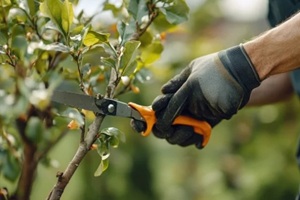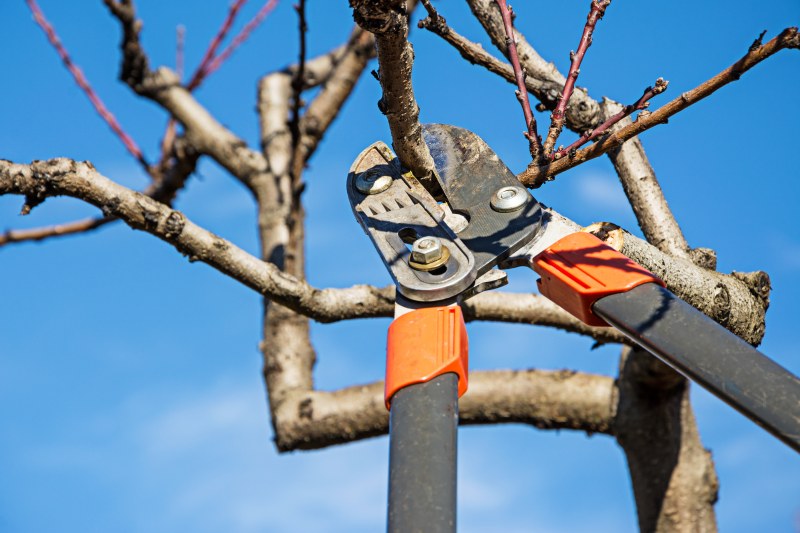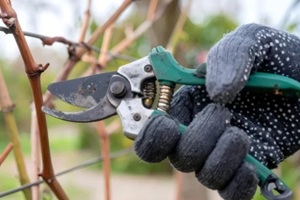
Effective tree pruning is one of the best methods to encourage robust growth and safeguard your landscape investment. When done properly, pruning improves the tree’s structure, helps prevent disease, and enhances the natural beauty of your landscape. Conversely, improper techniques can cause lasting damage that compromises both the health of the tree and its property value.
The basics of tree pruning enable property owners to make knowledgeable choices about when to seek professional help. This comprehensive guide covers those basics, including the techniques, timing considerations, and safety practices that support long-term tree health.
The Importance of Tree Pruning for Maintaining Tree Health
Tree pruning is important for tree health as it serves several functions beyond just enhancing appearance.
Disease Prevention and Management
Eliminating diseased, damaged, or dead branches helps stop the spread of pathogens within the tree.
Structural Integrity Enhancement
Well-pruned trees develop stronger branch systems that better withstand Virginia’s variable weather conditions. The earlier the better as the correct pruning of a tree or shrub during its formative years can help prevent many issues. However, in later years professional arborists have specific strategies for mature trees.
Air Circulation and Light Penetration
Proper pruning improves air movement through the canopy, reducing humidity levels that promote fungal diseases. Better light penetration encourages healthy foliage development throughout the tree rather than just at the exterior edges.
Tree Pruning Techniques
Professional arborists employ specific cutting methods that support natural healing processes while achieving desired outcomes. Understanding these techniques helps property owners recognize quality workmanship.
Crown Management Strategies
Professional crown management involves several specialized approaches depending on tree condition and landscape goals:

- Crown thinning selectively removes branches throughout the canopy to improve structure and health. This method enhances light penetration and airflow without negative impact to the natural shape of the tree.
- Crown raising involves removing lower branches to create clearance above walkways, driveways, and buildings. Gradual removal over several seasons prevents shock to the tree system.
- Crown cleaning emphasizes the removal of dead, dying, or diseased wood from the tree’s canopy. This preventive maintenance supports overall tree health while improving appearance.
Timing Your Tree Pruning Activities
Seasonal timing has a significant impact on pruning success and tree response. No matter the season, dead or unhealthy branches should always be pruned. Winter is a great time for most trees. Dormant trees respond well to winter pruning, and bare branches make it easier to see what needs to go. To prepare your trees for winter pruning, we recommend starting Plant Health Care in the fall.
Emergency Pruning Exceptions
Emergency pruning exceptions include situations such as storm damage, disease outbreaks, or safety hazards, which may necessitate immediate action regardless of the time of year. In these situations, proper technique becomes even more essential since trees must heal under less-than-ideal conditions.
Safety Considerations and Professional Standards
- Electrical hazards: Working near power lines requires specialized training and coordination with utility providers.
- Height and equipment risks: Climbing, aerial lifts, and chainsaw use demand certified professionals with proper insurance.
- Structural assessment: Large trees need evaluation of branch structure, decay, and load distribution to ensure safe pruning.
Pruning large trees carries serious risks, making trained, properly equipped arborists essential.
Common Tree Pruning Mistakes
Although some yardwork may be within a homeowner’s wheelhouse, pruning is best left to professional arborists. Here are a few of the most common mistakes we see from DIY efforts or untrained landscapers:
- Topping trees: Leaves stubs, weakens structure, distorts natural shape, and can shorten the tree’s life.
- Removing too much: Taking off more than 25% of foliage at once stresses the tree and reduces energy production.
- Pruning at the wrong time: Increases disease risk and slows natural recovery.
These errors can cause lasting harm, highlighting the importance of proper pruning practices.
Partner with RTEC Treecare for Professional Tree Pruning Excellence

Property owners throughout Virginia deserve tree care services that combine environmental responsibility with proven expertise. RTEC Treecare has ISA-certified arborists that bring nearly three decades of experience to every pruning project, guaranteeing your trees receive care that supports both immediate health and long-term vitality.
Our approach prioritizes preservation, advising only on essential interventions. This empowers you to make informed decisions that safeguard both your trees and your investment. We understand that your landscape represents a significant asset requiring knowledgeable stewardship.
Contact RTEC Treecare online or call (571) 506-6140 to schedule a consultation with our certified arborists. Let us help you develop a tree care strategy that enhances your property’s beauty, safety, and environmental value for generations to come.


